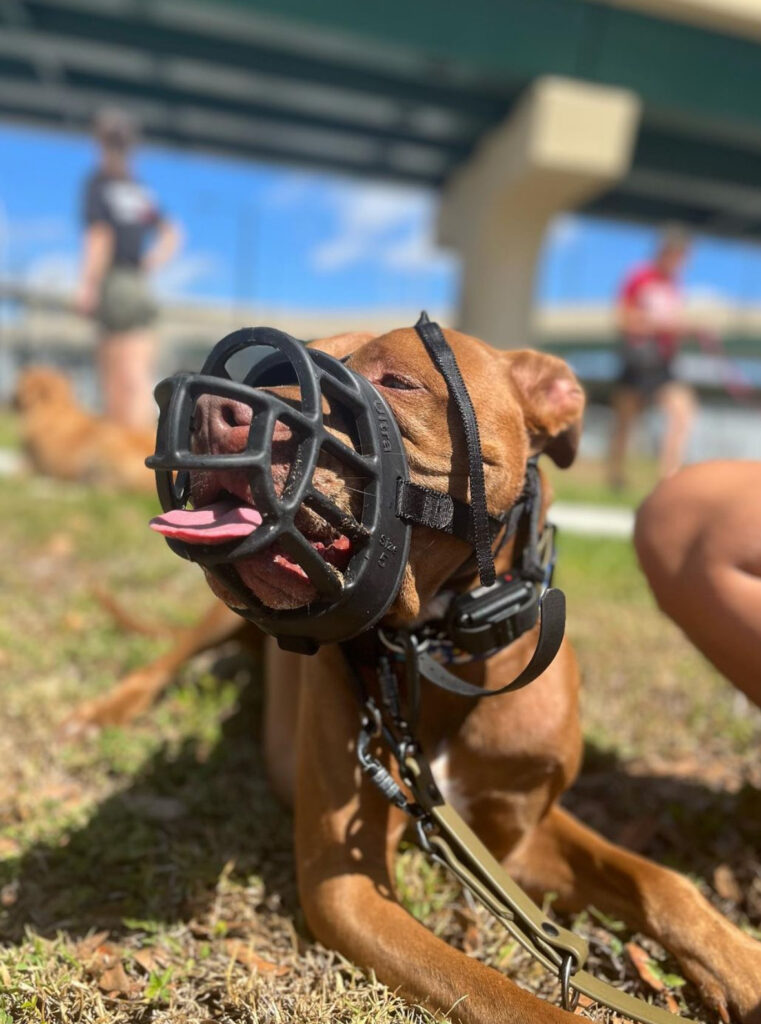When you hear the word “muzzle,” what comes to mind? For many dog owners, it might evoke images of aggressive dogs or harsh punishment. This negative stigma often overshadows the true benefits of muzzle training, making it a less common practice despite its potential to enhance safety and peace of mind for both dogs and their owners. We want explore why muzzle training is a valuable tool, comparing it to other safety measures we use in our daily lives, and how it can make a significant difference in your dog’s well-being and your own peace of mind.
Understanding the Muzzle: More Than Just a Safety Device
A muzzle is often misunderstood as a device meant to punish or control aggressive behavior. In reality, it’s a proactive safety tool that, when used correctly, can benefit both your dog and those around them. Think of it as a safety measure similar to seat belts in cars, helmets on bicycles, or life vests on boats—each serves a protective purpose, ensuring safety in potentially risky situations.
The Benefits of Muzzle Training

Enhanced Safety for All. Just like seat belts prevent serious injury in car accidents, muzzles help prevent bites in situations where a dog might feel threatened or overly stressed. This is particularly valuable in environments where your dog might encounter unfamiliar people or other animals. By using a muzzle, you’re adding an extra layer of safety that helps prevent accidents and gives you peace of mind.
Stress Reduction for Your Dog. Muzzles are not only about preventing harm but also about reducing anxiety. Dogs can feel more secure knowing they are not expected to react aggressively in high-stress situations. Muzzle training can help your dog become more comfortable in social settings, making them less anxious and more relaxed.
Preventing Unwanted Behaviors. Sometimes, a dog might act out due to fear or excitement. Muzzles can prevent them from engaging in undesirable behaviors, such as chewing on things they shouldn’t or accidentally injuring themselves or others. It’s a temporary solution that allows you to manage your dog’s behavior while you work on longer-term training and socialization.
Support During Veterinary Visits and Grooming. Veterinary visits and grooming sessions can be stressful for dogs, and even the most well-behaved pups can become anxious and reactive. A muzzle provides a safeguard that allows veterinarians and groomers to perform necessary procedures without the risk of bites or injuries.

Why the Stigma? Changing Perceptions
The stigma around muzzles often comes from misunderstandings or outdated views. Unlike their harsh portrayal in media, modern muzzles are designed with your dog’s comfort in mind. They are typically made of soft, breathable materials that allow for panting, drinking, and even eating, depending on the design.
Consider the safety measures we accept in our lives: seat belts might feel restrictive, helmets might seem cumbersome, and life vests might not be the most stylish accessory. Yet, we use these tools because they offer significant benefits and protection. Muzzles for dogs serve a similar purpose—they provide safety and peace of mind, ensuring that all interactions are as positive as possible.
Implementing Muzzle Training
- Choose the Right Muzzle: There are different types of muzzles, from basket muzzles that allow for panting and drinking to more restrictive types. Choose one that best suits your dog’s needs and comfort.
- Gradual Introduction: Introduce the muzzle slowly, allowing your dog to get used to wearing it in a positive and rewarding manner. Start with short periods and gradually increase the time as your dog becomes more comfortable.
- Positive Reinforcement: Use treats and praise to associate the muzzle with positive experiences. This will help your dog view the muzzle as a positive part of their routine rather than something to fear.
- Consult Professionals: If you’re unsure about how to start muzzle training, consult with a professional dog trainer or behaviorist. They can offer guidance tailored to your dog’s specific needs.

A Step Towards Better Safety
Muzzle training is a practical and beneficial tool for ensuring the safety of your dog, others, and yourself. By overcoming the negative stigma and viewing muzzles as a proactive safety measure, you can enhance your dog’s well-being and navigate potentially challenging situations with greater confidence.
Just as we accept safety gear in our own lives, embracing muzzle training for our dogs can provide invaluable protection and peace of mind. After all, ensuring the safety of our beloved pets is a responsibility we all share, and a muzzle can be a small but significant step toward that goal.
When you hear the word “muzzle,” what comes to mind? For many dog owners, it might evoke images of aggressive dogs or harsh punishment. This negative stigma often overshadows the true benefits of muzzle training, making it a less common practice despite its potential to enhance safety and peace of mind for both dogs and their owners. We want explore why muzzle training is a valuable tool, comparing it to other safety measures we use in our daily lives, and how it can make a significant difference in your dog’s well-being and your own peace of mind.
Understanding the Muzzle: More Than Just a Safety Device
A muzzle is often misunderstood as a device meant to punish or control aggressive behavior. In reality, it’s a proactive safety tool that, when used correctly, can benefit both your dog and those around them. Think of it as a safety measure similar to seat belts in cars, helmets on bicycles, or life vests on boats—each serves a protective purpose, ensuring safety in potentially risky situations.
The Benefits of Muzzle Training

Enhanced Safety for All. Just like seat belts prevent serious injury in car accidents, muzzles help prevent bites in situations where a dog might feel threatened or overly stressed. This is particularly valuable in environments where your dog might encounter unfamiliar people or other animals. By using a muzzle, you’re adding an extra layer of safety that helps prevent accidents and gives you peace of mind.
Stress Reduction for Your Dog. Muzzles are not only about preventing harm but also about reducing anxiety. Dogs can feel more secure knowing they are not expected to react aggressively in high-stress situations. Muzzle training can help your dog become more comfortable in social settings, making them less anxious and more relaxed.
Preventing Unwanted Behaviors. Sometimes, a dog might act out due to fear or excitement. Muzzles can prevent them from engaging in undesirable behaviors, such as chewing on things they shouldn’t or accidentally injuring themselves or others. It’s a temporary solution that allows you to manage your dog’s behavior while you work on longer-term training and socialization.
Support During Veterinary Visits and Grooming. Veterinary visits and grooming sessions can be stressful for dogs, and even the most well-behaved pups can become anxious and reactive. A muzzle provides a safeguard that allows veterinarians and groomers to perform necessary procedures without the risk of bites or injuries.

Why the Stigma? Changing Perceptions
The stigma around muzzles often comes from misunderstandings or outdated views. Unlike their harsh portrayal in media, modern muzzles are designed with your dog’s comfort in mind. They are typically made of soft, breathable materials that allow for panting, drinking, and even eating, depending on the design.
Consider the safety measures we accept in our lives: seat belts might feel restrictive, helmets might seem cumbersome, and life vests might not be the most stylish accessory. Yet, we use these tools because they offer significant benefits and protection. Muzzles for dogs serve a similar purpose—they provide safety and peace of mind, ensuring that all interactions are as positive as possible.
Implementing Muzzle Training
- Choose the Right Muzzle: There are different types of muzzles, from basket muzzles that allow for panting and drinking to more restrictive types. Choose one that best suits your dog’s needs and comfort.
- Gradual Introduction: Introduce the muzzle slowly, allowing your dog to get used to wearing it in a positive and rewarding manner. Start with short periods and gradually increase the time as your dog becomes more comfortable.
- Positive Reinforcement: Use treats and praise to associate the muzzle with positive experiences. This will help your dog view the muzzle as a positive part of their routine rather than something to fear.
- Consult Professionals: If you’re unsure about how to start muzzle training, consult with a professional dog trainer or behaviorist. They can offer guidance tailored to your dog’s specific needs.

A Step Towards Better Safety
Muzzle training is a practical and beneficial tool for ensuring the safety of your dog, others, and yourself. By overcoming the negative stigma and viewing muzzles as a proactive safety measure, you can enhance your dog’s well-being and navigate potentially challenging situations with greater confidence.
Just as we accept safety gear in our own lives, embracing muzzle training for our dogs can provide invaluable protection and peace of mind. After all, ensuring the safety of our beloved pets is a responsibility we all share, and a muzzle can be a small but significant step toward that goal.

Comments